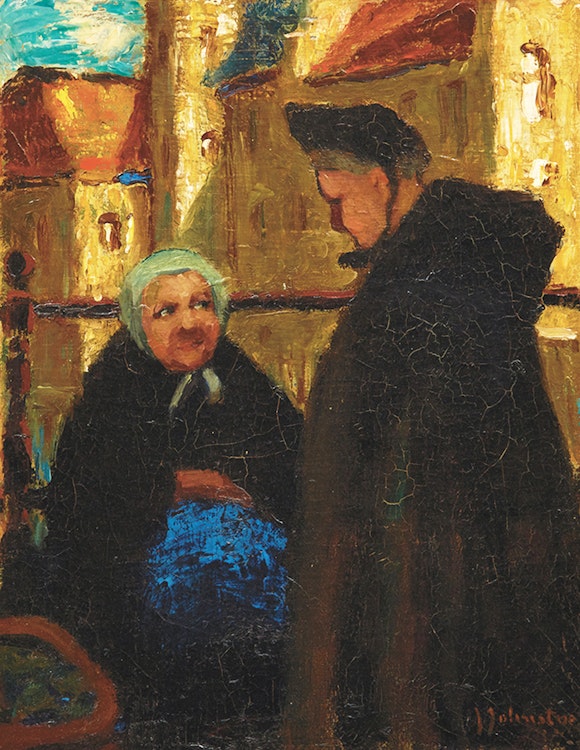Fishing Village, Bruges by John Young Johnstone

John Johnstone
Fishing Village, Bruges
oil on canvas
signed lower right
14 x 10.75 ins ( 35.6 x 27.3 cms )
Sale closed. Please contact us for details.
Walter Klinkhoff Gallery, Montreal
Private Collection, Toronto
John Y. Johnstone Retrospective Exhibition, Galerie Walter Klinkhoff, Montreal, September 2005, no. 11
A.K. Prakash, “Impressionism in Canada, A Journey of Rediscovery”, Stuttgart, 2015, page 603
In “Fishing Village, Bruges”, Johnstone depicts an intimate conversation between two women. The viewer is immediately drawn to the expression on the face of the seated woman and wonders, what are they talking about? Is a transaction about to take place for the day’s catch? As A.K. Prakash writes, “Although his subjects still reflected those favoured by the Impressionists, he strove now to capture the suspension of time rather than the fleeting moment in his paintings.” Johnstone has employed all the tools of Impressionism to capture this sentiment - cropping the composition, flattening the picture plane and accentuating the play of light and shadow on the buildings in the background.
Share this item with your friends
John Young Johnstone
(1887 - 1930) ARCA
Born in Montreal, Quebec, he studied at the Art Association of Montreal under William brymner, RCA, and in Paris at the Académie de la Grande Chaumière under Pau, Casteluche, Simon, and Ménard. His style was rather beautiful being a simplified realism also with the influence of the Impressionists. He was most successful in his early thirties. He exhibited his paintings at the Montreal Spring Shows and with the Royal Canadian Academy. He was elected ARCA in 1920. Newton MacTavish included him amongst the very fine painters in Canada in 1925 and his painting “A Quebec Village” was reproduced in MacTavish's “The Fine Arts in Canada”. The National Gallery of Canada acquired four of his canvases. In 1930 he went to Havana, Cuba, and somehow became destitute and died there at the age of 43.
Source: "A Dictionary of Canadian Artists, Volume I: A-F", compiled by Colin S. MacDonald, Canadian Paperbacks Publishing Ltd, Ottawa, 1977

